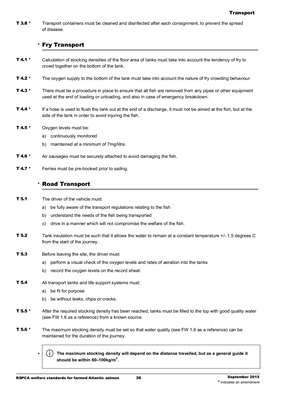
Transport
RSPCA welfare standards for farmed Atlantic salmon 36 September 2015
* indicates an amendment
T 3.8 * Transport containers must be cleaned and disinfected after each consignment, to prevent the spread
of disease.
* Fry Transport
T 4.1 * Calculation of stocking densities of the floor area of tanks must take into account the tendency of fry to
crowd together on the bottom of the tank.
T 4.2 * The oxygen supply to the bottom of the tank must take into account the nature of fry crowding behaviour.
T 4.3 * There must be a procedure in place to ensure that all fish are removed from any pipes or other equipment
used at the end of loading or unloading, and also in case of emergency breakdown.
T 4.4 * If a hose is used to flush the tank out at the end of a discharge, it must not be aimed at the fish, but at the
side of the tank in order to avoid injuring the fish.
T 4.5 * Oxygen levels must be:
a) continuously monitored
b) maintained at a minimum of 7mg/litre.
T 4.6 * Air sausages must be securely attached to avoid damaging the fish.
T 4.7 * Ferries must be pre-booked prior to sailing.
* Road Transport
T 5.1 The driver of the vehicle must:
a) be fully aware of the transport regulations relating to the fish
b) understand the needs of the fish being transported
c) drive in a manner which will not compromise the welfare of the fish.
T 5.2 Tank insulation must be such that it allows the water to remain at a constant temperature +/- 1.5 degrees C
from the start of the journey.
T 5.3 Before leaving the site, the driver must:
a) perform a visual check of the oxygen levels and rates of aeration into the tanks
b) record the oxygen levels on the record sheet.
T 5.4 All transport tanks and life support systems must:
a) be fit for purpose
b) be without leaks, chips or cracks.
T 5.5 * After the required stocking density has been reached, tanks must be filled to the top with good quality water
(see FW 1.6 as a reference) from a known source.
T 5.6 * The maximum stocking density must be set so that water quality (see FW 1.6 as a reference) can be
maintained for the duration of the journey.
*
The maximum stocking density will depend on the distance travelled, but as a general guide it
should be within 60-100kg/m
3.
i